Do you have a question about the Sharp Aquos LC-26GA4U and is the answer not in the manual?
General safety warnings, cautions, and explanations of symbols for safe operation.
Essential precautions for installation, operation, cleaning, and handling of the TV to prevent hazards.
Lists all items provided with the TV, including remote, batteries, cables, and manual.
Instructions for placing the TV, removing covers, connecting power, and managing cables.
Procedure for safely detaching the TV speakers, with precautions.
Steps for detaching the TV stand and guidelines for wall mounting installation.
Instructions for inserting batteries and proper usage of the remote control unit.
Labels and locations of TV buttons, indicators, and ports on the front panel.
Diagram and explanation of all input/output terminals and connectors on the rear of the TV.
Comprehensive guide to each button function on the remote control unit for operating the TV.
Guides for connecting antennas, cable converters, VCRs, and descrambler boxes for TV signal reception.
Procedures for turning the TV on/off and performing the initial setup for optimal viewing.
Explains various methods for changing TV channels using the remote control or display buttons.
Adjusting volume, using mute, Dolby Virtual effects, and setting MTS/SAP stereo modes for audio.
Overview of available picture adjustments for AV and PC inputs and their corresponding page references.
Step-by-step guide for initial TV setup, language selection, and antenna configuration.
Instructions for setting up and managing favorite channels and skipping unwanted channels.
How to register and delete favorite channels and select the display language.
Detailed guide to adjusting picture settings like brightness, contrast, color, sharpness, and advanced options.
Adjusting audio quality, treble, bass, balance, and enabling Dolby Virtual surround sound.
Options for automatic power shut-off based on signal or inactivity to save energy.
Important notes, copyright, recording formats, and capacity information for using memory cards.
Procedures for setting up, ejecting, and selecting modes for memory card operations.
How to record, display, and manage still images and create slide shows from memory cards.
Customizing slide show intervals, order, and creating personalized picture sequences.
Protecting, unprotecting, deleting, and deleting all still image files on the memory card.
Playing back, recording motion pictures, and setting recording modes (Rec. Mode, Pre Record).
Protecting, unprotecting, deleting, and deleting all motion picture files on the memory card.
Procedure for formatting the memory card, which erases all data.
Guides for connecting and displaying images from various external devices like DVD players, VCRs, PCs, and HDMI equipment.
How to adjust the horizontal and vertical position of the picture when using AV input sources.
Instructions and precautions for connecting external speakers to the TV for enhanced audio output.
Optimizing audio quality for attached speakers by selecting equalizer or flat sound profiles.
Automatic and manual adjustments for synchronizing PC input images for optimal display.
Selecting input signal types and customizing input labels for connected external equipment.
Options to flip or mirror the picture orientation and to assign custom names to input sources.
Selecting preset AV modes and viewing options for 4:3 programs to match content.
Selecting screen sizes and display modes for PC input signals to optimize picture presentation.
Setting PC input signals and applying digital noise reduction for clearer video.
Selecting audio output destinations and setting a timer for automatic TV standby.
Configuring closed caption display, including size, font, color, opacity, and edge effects.
Setting and managing a secret number for parental control and V-Chip features.
Configuring V-Chip levels and understanding TV parental guidelines and movie rating systems.
Procedures to temporarily release V-Chip blocking and how to reactivate it.
Using TV speakers as a center speaker for 5.1ch surround sound systems.
Displaying multiple pictures simultaneously or a moving image with a captured still image.
Programming the TV remote to control other AV devices by entering manufacturer codes.
Lists of manufacturer codes for VCR, DVD/LD, CATV, and Audio brands for remote control programming.
Using the remote control for cable converter and satellite tuner operations.
Operating VCR and DVD players using the TV remote control's dedicated buttons.
Solutions for common problems like no power, picture issues, sound problems, and unit operation errors.
Chart detailing PC compatibility resolutions and signal types supported by the TV.
Technical details for PC control via RS-232C port, including communication settings and command formats.
Terms and conditions of the consumer limited warranty, including coverage and service procedures.
General safety warnings, cautions, and explanations of symbols for safe operation.
Essential precautions for installation, operation, cleaning, and handling of the TV to prevent hazards.
Lists all items provided with the TV, including remote, batteries, cables, and manual.
Instructions for placing the TV, removing covers, connecting power, and managing cables.
Procedure for safely detaching the TV speakers, with precautions.
Steps for detaching the TV stand and guidelines for wall mounting installation.
Instructions for inserting batteries and proper usage of the remote control unit.
Labels and locations of TV buttons, indicators, and ports on the front panel.
Diagram and explanation of all input/output terminals and connectors on the rear of the TV.
Comprehensive guide to each button function on the remote control unit for operating the TV.
Guides for connecting antennas, cable converters, VCRs, and descrambler boxes for TV signal reception.
Procedures for turning the TV on/off and performing the initial setup for optimal viewing.
Explains various methods for changing TV channels using the remote control or display buttons.
Adjusting volume, using mute, Dolby Virtual effects, and setting MTS/SAP stereo modes for audio.
Overview of available picture adjustments for AV and PC inputs and their corresponding page references.
Step-by-step guide for initial TV setup, language selection, and antenna configuration.
Instructions for setting up and managing favorite channels and skipping unwanted channels.
How to register and delete favorite channels and select the display language.
Detailed guide to adjusting picture settings like brightness, contrast, color, sharpness, and advanced options.
Adjusting audio quality, treble, bass, balance, and enabling Dolby Virtual surround sound.
Options for automatic power shut-off based on signal or inactivity to save energy.
Important notes, copyright, recording formats, and capacity information for using memory cards.
Procedures for setting up, ejecting, and selecting modes for memory card operations.
How to record, display, and manage still images and create slide shows from memory cards.
Customizing slide show intervals, order, and creating personalized picture sequences.
Protecting, unprotecting, deleting, and deleting all still image files on the memory card.
Playing back, recording motion pictures, and setting recording modes (Rec. Mode, Pre Record).
Protecting, unprotecting, deleting, and deleting all motion picture files on the memory card.
Procedure for formatting the memory card, which erases all data.
Guides for connecting and displaying images from various external devices like DVD players, VCRs, PCs, and HDMI equipment.
How to adjust the horizontal and vertical position of the picture when using AV input sources.
Instructions and precautions for connecting external speakers to the TV for enhanced audio output.
Optimizing audio quality for attached speakers by selecting equalizer or flat sound profiles.
Automatic and manual adjustments for synchronizing PC input images for optimal display.
Selecting input signal types and customizing input labels for connected external equipment.
Options to flip or mirror the picture orientation and to assign custom names to input sources.
Selecting preset AV modes and viewing options for 4:3 programs to match content.
Selecting screen sizes and display modes for PC input signals to optimize picture presentation.
Setting PC input signals and applying digital noise reduction for clearer video.
Selecting audio output destinations and setting a timer for automatic TV standby.
Configuring closed caption display, including size, font, color, opacity, and edge effects.
Setting and managing a secret number for parental control and V-Chip features.
Configuring V-Chip levels and understanding TV parental guidelines and movie rating systems.
Procedures to temporarily release V-Chip blocking and how to reactivate it.
Using TV speakers as a center speaker for 5.1ch surround sound systems.
Displaying multiple pictures simultaneously or a moving image with a captured still image.
Programming the TV remote to control other AV devices by entering manufacturer codes.
Lists of manufacturer codes for VCR, DVD/LD, CATV, and Audio brands for remote control programming.
Using the remote control for cable converter and satellite tuner operations.
Operating VCR and DVD players using the TV remote control's dedicated buttons.
Solutions for common problems like no power, picture issues, sound problems, and unit operation errors.
Chart detailing PC compatibility resolutions and signal types supported by the TV.
Technical details for PC control via RS-232C port, including communication settings and command formats.
Terms and conditions of the consumer limited warranty, including coverage and service procedures.
| Screen Size | 26 inches |
|---|---|
| Display Type | LCD |
| Resolution | 1366 x 768 |
| Aspect Ratio | 16:9 |
| Contrast Ratio | 800:1 |
| Brightness | 450 cd/m² |
| HDMI Ports | 1 |
| USB Ports | 0 |
| Component Video Inputs | 1 |
| S-Video Inputs | 1 |
| Composite Video Inputs | 1 |
| Power Consumption | 120W |
| PC Input | Yes |
| Viewing Angle | 170 degrees |
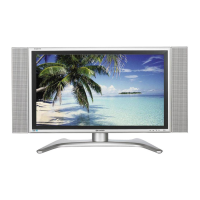
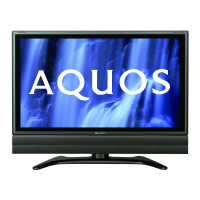

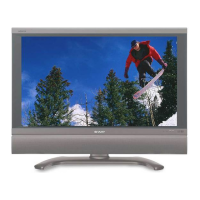

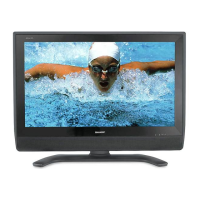
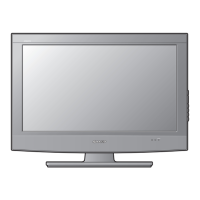

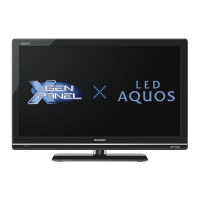
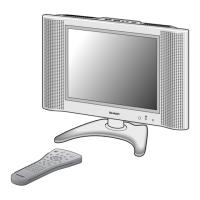
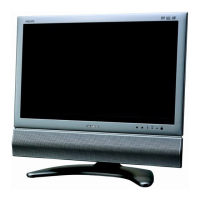
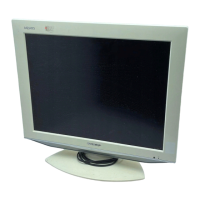
